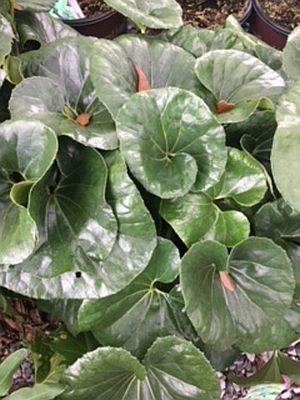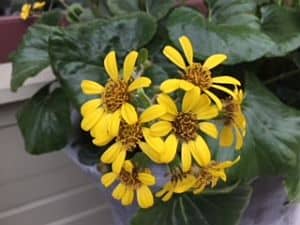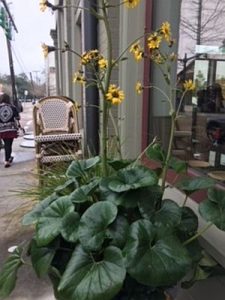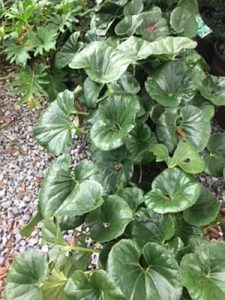
Ligularia/Leopard plant
This herbaceous perennial was previously known as Ligularia tussilaginea and Ligularia kaempferi. Now known as Farfugium japonicum. Ligularia or Leopard plant is a member of the Asteracea (sunflower) family. It is native to rocky coastal areas of Japan, Korea and Taiwan.
Ligularia should be planted at the front or middle of the garden bed. They look great in containers with other plants or as a specimen plant. They bloom from Spring to Fall but I could not help notice the shiny foliage plus the large daisy-like yellow blooms that are still blooming. Of course, now that I say this, we’ll have a freeze to wipe out the foliage. Ligularias grow to a compact 2 ft with evergreen clumps of large shiny kidney shaped foliage. They are grown for the beautiful large foliage as opposed to the blooms.
Ligularia likes moist rich soil and grows best in partial sun to shade. This plant will wilt when too dry or too much sun. Fertilize this plant in early Spring and in Summer. Divide the clumps of this slow growing plant when they get too crowded. Ligularia can be grown from collected seeds. Can be planted anytime from containers. Cut off old stalks after flowers fade.
Butterflies and bees pollinate the flowers. Pests, insects and disease issues are rare. Rabbits, slugs and snail can be an occasional issue. Reportedly, deer don’t seem to bother Ligularia.
Other varieties are available but will not thrive in our humidity. Ligularia will dieback in freezing temperatures but will return in Spring. So far, they seem to like the cold/wet weather we are having right now.

Some varieties include;
- Argentea-flacous Green foliage with creamy white spots.
- Aureo-maculata (leopard plant), Yellow-green with yellow spots.
- Crispata-Parsley ligularia. Large ruffled leaves. Covered with gray-brown pubescence.
- Desdemona golden daisey-like flowers with purple-green foliage.
- Gigantea glossy leaves up to 15 inches around. Clumps are 3 ft across.
By Karen Blackburn



